How to grow a good harvest of garlic?
For every gardener, growing garlic is an important task. Planted next to other vegetable crops, it protects them from aphids and other pests, and the harvested crop provides the whole family with vitamins. Not only garlic heads, but also leaves are filled with useful substances, therefore the vegetable has been popular for many peoples of the world for many thousands of years. It is used in cooking, cosmetology and medicine.
A good harvest can be obtained in two ways: spring and winter. The technology of growing garlic in spring and before winter does not differ much. It is necessary to properly prepare planting material, beds and provide good care.
How to plant garlic in autumn
For the planting of garlic to be successful, you need to choose the right garden bed. The vegetable grows best in soil that has previously contained annual crops such as tomatoes or cucumbers. They do not drain the soil much.
Important!
Remember not to plant garlic in one place for several years in a row. It is imperative to give the land a rest for 3-4 years.
Before winter, you can plant a vegetable with cloves and bulbs, which are collected from the ripe arrows of the plant. Their teeth for the next summer are large bulbs, and from the bulbs - small heads with one tooth (sets). It is dug up and dried well. Sevok can be used for food, but it is better to plant it in the ground again and get massive heads.
The quality of winter planting material is of great importance. Be sure to carefully sort it out, rejecting dry, deformed, rotten cloves. Then disinfect in saline solution. To do this, dissolve 3 tbsp. l. salt in 5 liters of water and soak the teeth in it for 2 minutes. Then complete the disinfecting treatment with a minute treatment in a solution of copper sulfate, diluting a teaspoon of the product in 10 liters of water.
Soil preparation
To grow garlic outdoors to produce a rich harvest, set up a garden in a sunny area.
- Dig it deep a few weeks before planting and fertilize with 30 g of superphosphate, 20 g of potassium salt and 5 kg of humus. The amount of substances is calculated for 1 m² of area. Such care will greatly increase yields.
- To kill pests and diseases, spray the ground with a solution of copper sulfate, which you do in the same way as for soaking the teeth, and cover the soil with foil before planting.
Advice
Winter garlic is planted in mid-September. It is important to do this a month and a half before the cold weather, so that the seedlings develop a good root system. Then they will easily endure severe frosts.
Garlic is planted in grooves 20 cm deep, which are made at a distance of 25 cm. A layer of river sand is poured inside to exclude contact of the cloves with the soil and to prevent rotting of the planting material. Place each tooth with the spine down at intervals of 15 cm. Bulbules are sown every 2–3 cm.
The grooves are buried with earth and the crops of winter garlic are sprinkled with a thick layer of sawdust or peat. If the winter is very frosty, it is recommended to insulate the bed with roofing felt, which must be removed at the first sign of warming.
Subtleties of care
Garlic is an unpretentious culture, and caring for it is simple. In early spring, clear the bed from the layer of sawdust, and as soon as the sun warms up, the young leaves will quickly grow. At this time, the first nitrogen fertilization is applied. You can use organic fertilizers - mullein, urea - or purchase commercial nitrogen-containing products.
In mid-June, the vegetable begins to release arrows. Break them off while they are short, otherwise the head will be shallow.For better bulb formation, moisten the ground with a solution of wood ash in early July. Prepare it at the rate of 200 g per 10 liters of liquid.
Caring for a vegetable involves regular watering, especially at a time when the green leaves are actively growing. Then it should be reduced, because excess moisture provokes the development of fungal diseases and contributes to the production of garlic.
To maintain complete care, regularly loosen the soil between the rows and break through the grass.
Digging up winter garlic takes place in early August or late July. During this period, the leaves turn yellow and begin to slope downward. This means that the heads are ripe. Choose a sunny day for work to thoroughly dry the dug out vegetable. It is useful to leave it in the fresh air for several days. Then it is perfectly stored until the next harvest.
Planting in spring
Planting garlic in spring gives a great harvest with minimal maintenance time.
- Store the seed heads during the winter in a cool place at a temperature of about 5 ° C.
- 10 days before planting the spring garlic, disassemble the large healthy bulbs into cloves and wrap them in a damp natural cloth.
- Lower the planting material into the basement and periodically re-soak the fabric with water.
- Such care will allow long roots to hatch, and sowing will be more successful.
Planting spring garlic begins as soon as it gets warmer and the ground warms up a little. This is usually done during April. Dig up the area in advance and apply mineral fertilizers. Make grooves on it 8 cm deep and place them at a distance of 20-25 cm from each other. It is important that the aisles are easy to weed and provide other maintenance.
Arrange the spring garlic cloves evenly at a distance of 8-10 cm and cover the grooves with soil.
Care methods
The main thing is not only to know how to plant garlic correctly. It is necessary to provide him with proper care, which has its own characteristics when planting in spring. More watering is required than a winter vegetable, especially in the spring when the leaves are growing. If there are no lingering rains, moisten once a week, remembering to carefully weed the weed bed after that.
- In June, the plant needs nitrogen fertilization. To do this, dissolve a spoonful of urea, 250 g of mullein in 10 liters of water and moisten the soil with liquid. After 10 days, feeding is recommended to be repeated.
- During the summer, combine watering with organic fertilization every 20 days. Dissolve the mullein 1:10 in water and use.
- When a lush green mass forms, feed the ground with a light pink manganese solution, in which dilute 15 g of urea in 10 liters of water.
- To get large bulbs of spring garlic, fertilize the soil with a special liquid during their formation. To prepare it, add 2 tablespoons to 10 liters of water. l. superphosphate and a spoonful of potassium chloride.
Dig up garlic at the end of summer, when the foliage withers and bows to the ground.
Why do shoots turn yellow
In summer, you can sometimes notice that the tips of the leaves turn yellow in garlic. If it's not yet time for cleaning, this is a reason to be wary. There may be several reasons:
- disease;
- onion fly worms;
- lack of minerals;
- lack of watering.
Diseases often occur with improper seed preparation. therefore before planting garlic, treat it with saline, copper sulfate, or a weak manganese solution. When the leaves turn yellow, pluck one garlic from the ground. If mold is visible on the bulb and the roots are darkened, the plant is infected with bacterial rot. It is difficult to treat it. You can use Fitosporin-M. This microbiological preparation copes well with fungal infections. Dilute it according to the instructions and process the garlic in the garden.
If you notice that the leaves are infested with tiny larvae, wash them off with saline. To do this, dissolve 200 grams of salt in a bucket of water.The onion fly larvae will quickly disappear and the plant will recover.
The lack of minerals is replenished by timely feeding. If the reason is dry weather, adjust the watering so that the bed does not dry out.
With the right seed selection, growing garlic at home yields an excellent harvest that keeps well. To get seedlings for planting before winter, plant the bulbs in early spring in open ground. Then in early August, you will dig up good material for the autumn planting.
For better storage, garlic can be tied in small bunches and hung in a well-ventilated area.

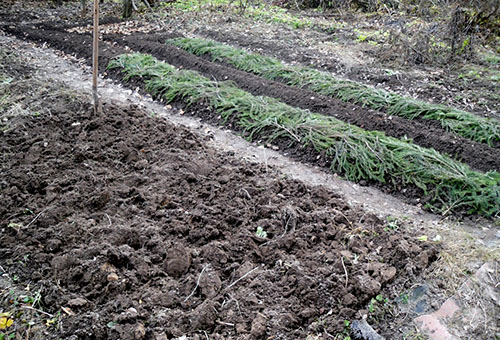
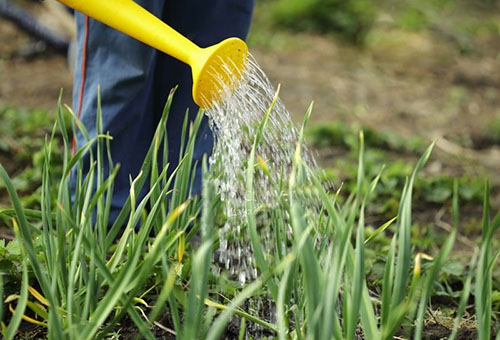
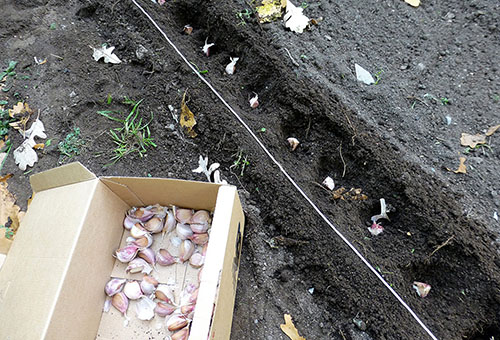
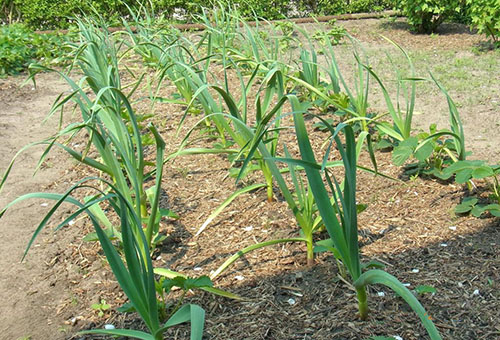
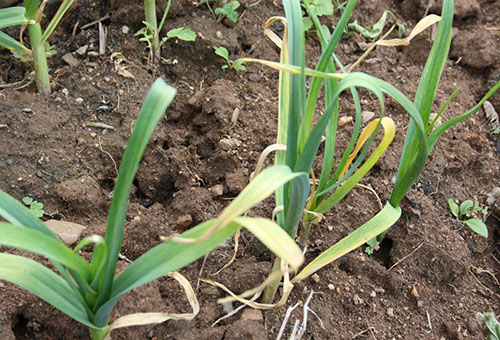
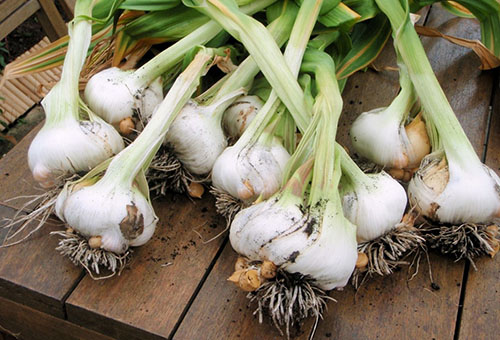

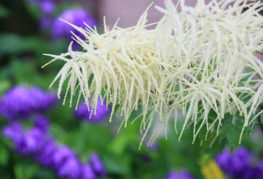
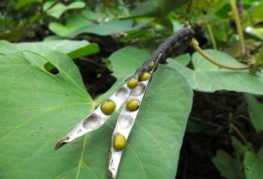
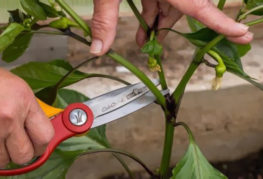
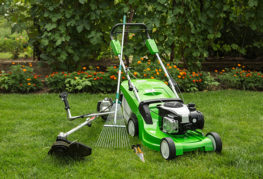
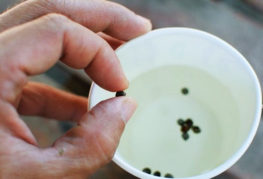
and will be published shortly.